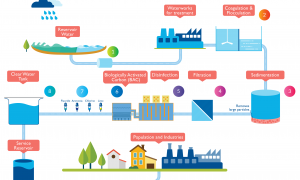🕑 Reading time: 1 minute
In an open channel flow, velocity distribution is non-uniform which means velocity is different at different depths. Various Factors such as channel slope, alignment, shape, roughness etc plays key role in velocity distribution.Contents:
Velocity Distribution in Open Channels
An open channel is a conduit which has free water surface exposed to the atmosphere. Rivers, canals etc come under open channel category. Because of free water surface and frictional resistance along the channel boundary velocity distribution is non-uniform in open channels. To measure velocity of open channel at required depth, Pitot tube or current meter are used. In general, to find average velocity of a particular open channel, velocity at a depth of 0.6 m from free water surface is measured. In the other case, velocity at 0.2 m depth, 0.8 m depth from free water surface is taken and average velocity of these two values is considered as channel average velocity.
Fig 1: Open Channel Flow
Factors Affecting Velocity Distribution in Open Channels
Velocity distribution in open channels is mainly depends upon the following factors.- Shape of the channel section
- Roughness of channel
- Alignment of channel
- Slope of Channel bed
1. Shape of the Channel Section
Open channels may be naturally formed or artificially developed. Natural open channels do not have any particular shape and they contain irregular sections while artificial channels are provided with certain designed shapes such as rectangular, circular, trapezoidal, triangular etc. Contour lines of equal velocities in different shapes of channel sections are shown in below figure.
Fig 2: Contour lines of Equal velocities in Different Channel Sections
2. Roughness of Channel
Roughness of channel is the measure of amount frictional resistance offered by channel bed material against flow of water. In natural channels, the flow velocity is affected by the presence of large angular boulders as bed material, vegetation, obstructions etc. If the channel is made of smooth clay or silt, its roughness is very low and water flows faster. In case of artificial channels, smooth finishing is required to maintain required flow velocity. The average velocity in open channels can be calculated using manning’s formula mentioned below. Where,
V = Average velocity of channel
R = hydraulic radius of channel = Area/Perimeter
S = Slope of channel
n = Manning’s roughness coefficient
Manning’s roughness coefficient values are different for different materials used to construct channels and the values for different materials are tabulated below.
Table 1: Manning's Roughness Coefficient (n) values for Different Types of Channel Materials
Where,
V = Average velocity of channel
R = hydraulic radius of channel = Area/Perimeter
S = Slope of channel
n = Manning’s roughness coefficient
Manning’s roughness coefficient values are different for different materials used to construct channels and the values for different materials are tabulated below.
Table 1: Manning's Roughness Coefficient (n) values for Different Types of Channel Materials
| Channel Surface Material | Channel Condition/Description | Manning’s Roughness Coefficient (n) |
| Earth | Newly excavated | 0.018 |
| After weathering | 0.022 | |
| Gravel | 0.025 | |
| No vegetation | 0.028 | |
| Grass and Weeds | 0.030 | |
| Presence of Aquatic Plants | 0.035 | |
| Earth bottom and rubble sides | 0.030 | |
| Stoney bottom and weedy banks | 0.035 | |
| Cobble bottom and Clean sides | 0.040 | |
| Rock cuts | Smooth and uniform | 0.035 |
| Jagged and irregular | 0.040 | |
| Concrete | Trowel finish | 0.013 |
| Float finish | 0.015 | |
| Finished with gravel on bottom | 0.017 | |
| unfinished | 0.017 | |
| Gunite, good section | 0.019 | |
| Gunite, wavy section | 0.022 | |
| on good excavated rock | 0.020 | |
| on irregular excavated rock | 0.027 | |
| Brick | Glazed bricks | 0.013 |
| Cement mortar finish | 0.015 | |
| Asphalt | Smooth | 0.013 |
| Rough | 0.016 | |
| Wood | Planed, untreated | 0.012 |
| Planed, creosoted | 0.012 | |
| Unplaned | 0.013 | |
| Plank with battens | 0.015 | |
| Lined with roofing paper | 0.014 | |
| Masonry | Cemented rubble masonry | 0.025 |
| Dry rubble masonry | 0.032 |

Fig 3: Velocity Distribution Curves for Different Channel Sections
3. Alignment of Channel
The velocity of flow in channel also depends up on the alignment of channel. If the channel is straight there will be no change is velocity with respect to alignment. In straight channels, maximum velocity is generally occurs at 0.05 to 0.15 m depth from free water surface. If it is sinuous or meandering, the velocity will vary at bends. At bend, due to centrifugal action of flow the velocity becomes more at convex side compared to concave side.
Fig 4: Different Channel Alignments
4. Slope of Channel Bed
Slope of channel bed or gradient of channel will also effects the velocity of flow in open channels. At steeper gradients, velocity increases while at normal gradients velocity decreases.
Fig 5: Channel Slope


